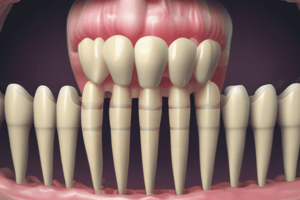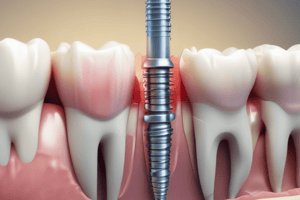Podcast
Questions and Answers
What is one of the disadvantages of Fast Set base material?
What is one of the disadvantages of Fast Set base material?
- Irritating action on the pulp (correct)
- Good bonding with dentin
- Long setting time
- Good bonding with pulp
What is a characteristic of the Soluble base material?
What is a characteristic of the Soluble base material?
- Good bonding with dentin
- Acidic (correct)
- Poor bonding with pulp
- Irritating action on the pulp
What is a disadvantage of the Soluble base material?
What is a disadvantage of the Soluble base material?
- Poor bonding with dentin (correct)
- Long setting time
- Irritating action on the pulp
- Good bonding with dentin
What is a characteristic of the Fast Set base material?
What is a characteristic of the Fast Set base material?
What is a common characteristic between Fast Set and Soluble base materials?
What is a common characteristic between Fast Set and Soluble base materials?
What is NOT a characteristic of the Fast Set base material?
What is NOT a characteristic of the Fast Set base material?
What is a disadvantage of the Fast Set base material?
What is a disadvantage of the Fast Set base material?
What is NOT a characteristic of the Soluble base material?
What is NOT a characteristic of the Soluble base material?
Flashcards are hidden until you start studying
Study Notes
MTA Modification
- Theracal: a modification of MTA with added resin
- Bioaggregate: a modification of MTA with nano particles
- Biodentin: a modification of MTA in capsule form
Characteristics of MTA Modifications
- Less solubility than traditional MTA
- Lower solubility than traditional MTA
- High antimicrobial action
- Compressive strength similar to mechanical properties of dentin
- Response to pulpal protection and sealing of dentin tubules
Dental Pulp Functions
- Formative: involved in tooth development
- Nutritive: provides nutrients to the tooth
- Sensory: involved in sensing pain and temperature
- Defensive: protects the tooth from injury
Dental Pulp Irritation
- Caused by direct pulp capping
- Results in pain and inflammation
Dental Pain Theory
- Hydrodynamic Theory: pain caused by fluid movement in dentinal tubules
Actual Cutting in Dentin
- Every square millimeter of dentin cut exposes 30,000 to 45,000 dentinal tubules
- Leads to pulpal tissue irritation
Bioactive Materials
- Materials that elicit a reparative response from the dental pulp
- Formation of hydroxyapatite crystals (Ca silicate)
- Examples: fast set, soluble, and bioactive materials that have an irritating action on the pulp
Studying That Suits You
Use AI to generate personalized quizzes and flashcards to suit your learning preferences.




